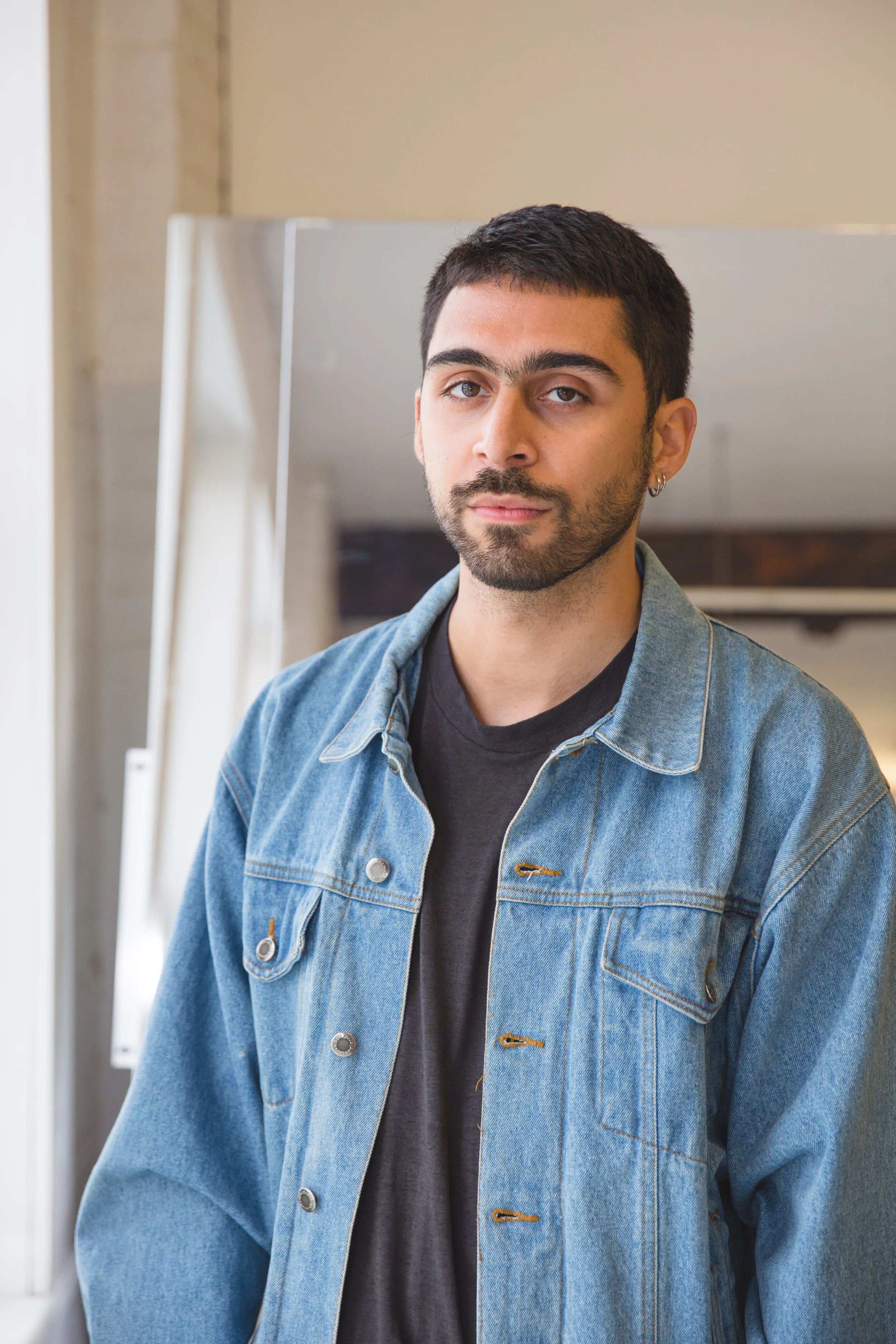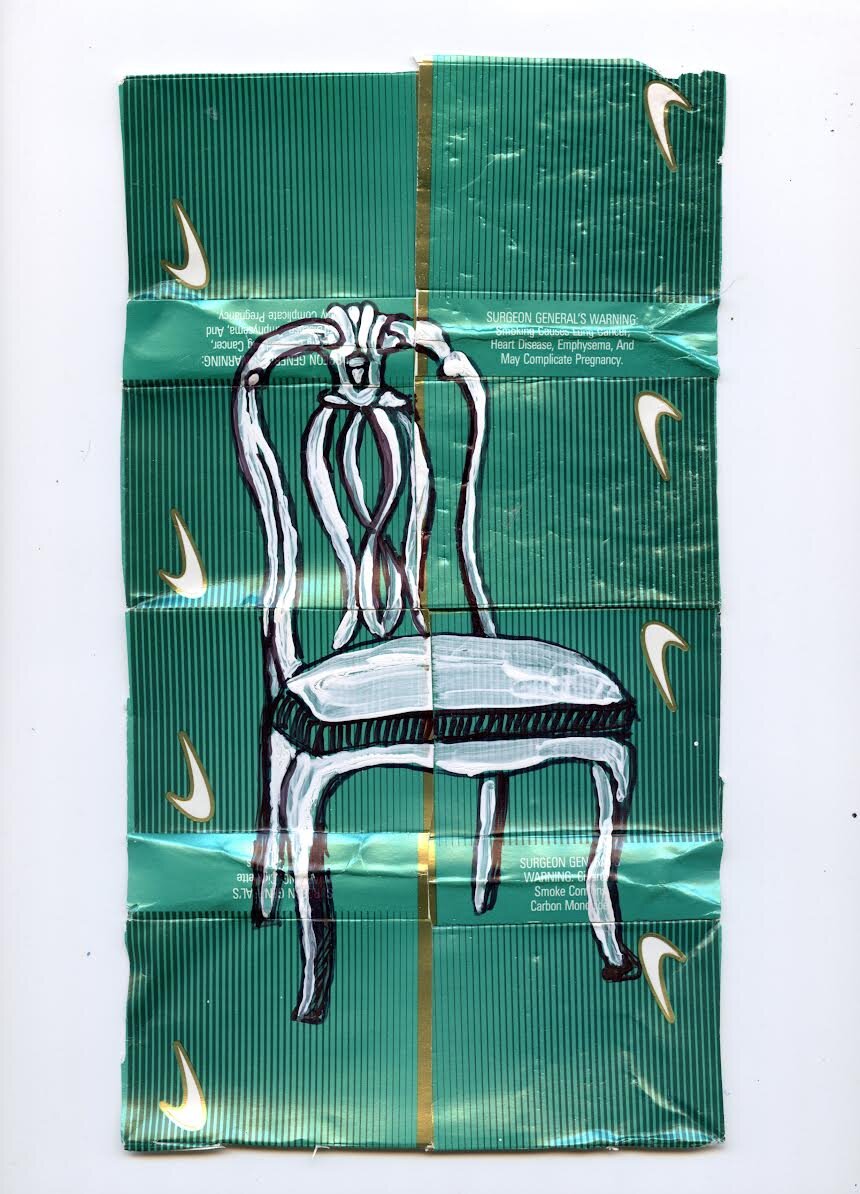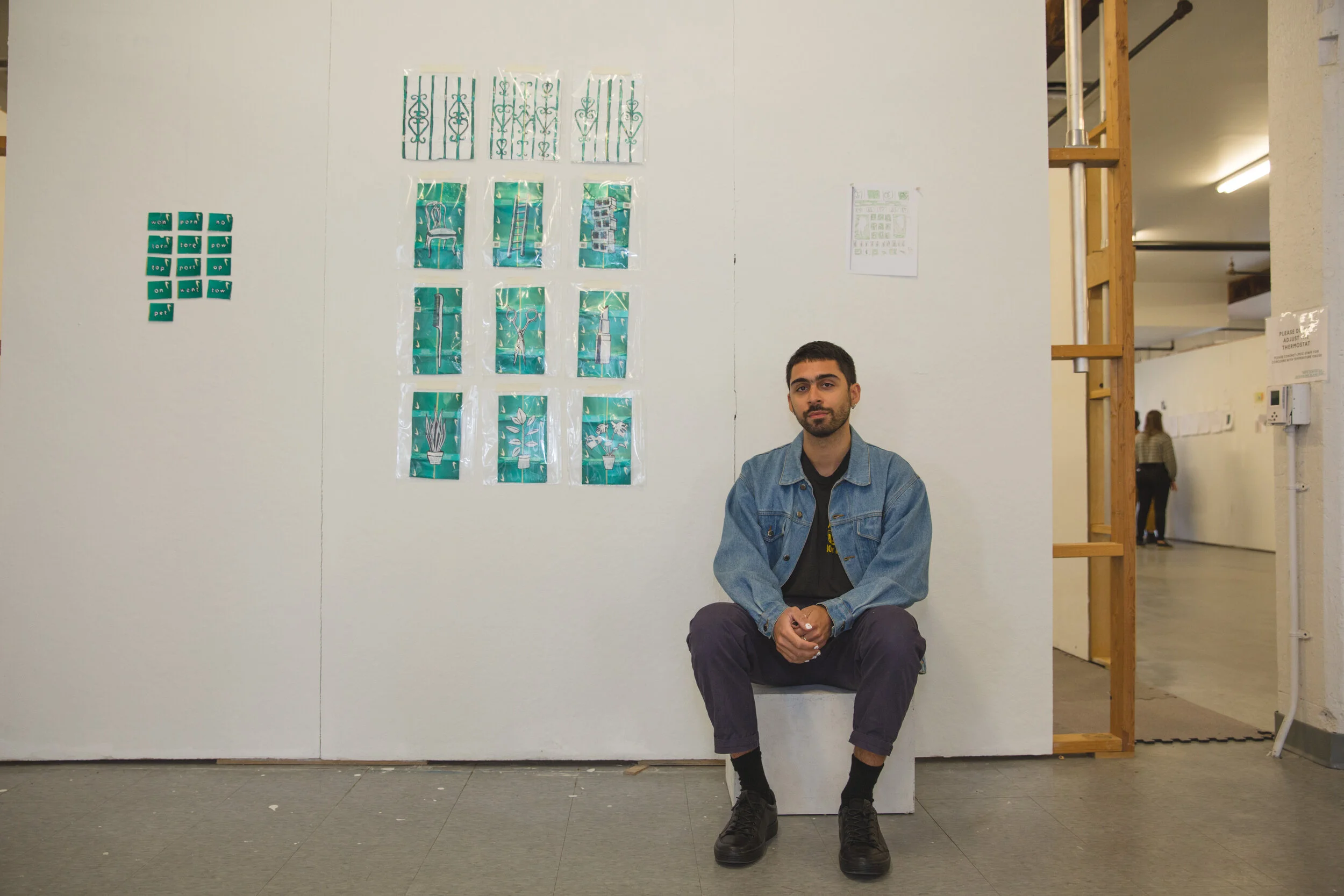A Thrilling Conversation with Marco DaSilva
Portrait by Ian Douglas at The Arts Center, Governors Island, 2021
Marco DaSilva is a Brazilian-American multimedia artist, primarily working in painting and drawing. His work explores his symbology amidst explorations of his multi-racial, queer and manic experience. He has been the NYFA Artist as an Entrepreneur Fellow and a Visual Art Fellow for Queer|Art|Mentorship’s 2017-2018 cycle. Marco’s work has been featured in The New York Times, Hyperallergic, and in NBC OUT’s “12 queer artists whose work is making us pay attention”. He is currently an artist-in-residence at LMCC’s Arts Center. His work has been exhibited nationally in art spaces such as Samuel Dorsky Museum of Art, Greenpoint Gallery, The LGBT Community Center, and elsewhere. I had the pleasure and honor of asking Marco about why he creates art, how art and being queer intersect for him, about mental health, and how art can heal.
UZOMAH: Can you discuss your process and technique in terms of how you create art?
MARCO: I’m inspired by moments from my life that have moved me to reflect on them in a specific way. Creating work about them is a way of processing and making sense of them. This can manifest in multiple steps and different ways of making. I keep a sketchbook where I do loose drawings about ideas that I have and some writing about what I’m exploring. Writing down definitions of words and making lists of concepts are as important as sketches of things I’m working through in drawings. I choose materials and mediums specific to each project. The color palette is extremely important to me and I’m always intentional about the colors I choose and what they mean to me in the context of the work I’m making. Once I have a vision for what I want to make, I like to create a small sketch mapped out that's like a key. I use that as a plan to guide me. My process is very much about reaching a blueprint, and from there, I try to really bring that vision to life.
“Empire State Casper,” 2020, latex paint, plastic rhinestones, hot glue, 65" x 18" each
U: Why do you create art?
M: When I was in undergrad, I spent a year working on my thesis, which was about a manic episode where I experienced a spiritual rebirth and felt like I found my purpose as an artist. After that, I couldn’t stop. Creating art has been a way to explore my identity and express myself as much as it is about storytelling and bringing people together. There's a private and ritualistic aspect of creating work that is just as important as the communal aspect of sharing it. Both are healing in a way. It’s about experimentation and finding beauty in pain, and problem-solving. Making art has kept me alive and gives me a reason to look forward to whatever comes next.
“Por New (Ladder),” 2021, house paint and marker on Newport boxes, 6 x 10 inches
U: What are some challenges you have faced being queer in the Latino community?
M: The expectations around being a man and what that means. Growing up, I had feminine and creative interests, and I loved drawing the spice girls and people with tattoos and piercings and dressing up as a witch and other characters. Especially as a younger child, it was challenging when I didn’t fit into those standards, which made me different and scared my parents at the time. I grew up in Chelsea in the 90’s so it was interesting being surrounded by so much queer culture and sex shops and gay porn in the windows. There were even queer Latinos in the building I grew up in, but it was also made very clear to me that the lifestyle was wrong. Growing up with these expectations can be hard on any young queer person.
“Street Vendor Collage Scans,” 2020, ribbon, rhinestones, plastic bags, magnet, 4" x 6" each
U: If you were not in art what would you be doing?
M: That’s really hard to say. Maybe a writer or a musician.
“Em Casa,” 2019, latex paint, plastic flowers, plastic combs, 42” x 90”
U: Where do art and being queer intersect for you?
M: I think being queer forces you to be creative about your life at an early age for your own survival. Because we fit outside of society's expectations around tradition, this gives us room for possibility. My experiences as a queer person have formed a lot of my recent work and is a reflection of the way I view the world through a queer lens. I recently directed ‘Empire State Kareoke,’ a black and white performance video where I am getting ready for this party, and I dress up in clown drag with long nails and jewelry and drink and dance by myself, which was inspired by former lovers and unrequited desire. The audio is of my voice singing ‘Back to Black’ by Amy Winehouse with autotune. I had made a performance piece a few years before, and for this one, I felt more comfortable expressing a more queer persona which isn’t me in my every day but is definitely a part of me that I am able to tap into. I also created five-building-shaped paintings in the colors of black, white, and red, and each one presented symbols about these men with red rose petals falling down them. The paintings, the palette, and the video were inspired by mourning and had a funeral feeling to them.
U: How has colorism been a factor in dividing the Afro Latino and Latino communities?
M: There’s a denial of proximity to blackness in Latin America and the US. My father’s family is Afro- Brazilian, and I’ve seen it firsthand. The experience of being Latinx is vast, but sadly the representation we see in culture and TV are people who are light-skinned which is due to white supremacy-even in Brazil, a country that is very black.
“Don’t Give Up! x Venha Ver Para Crer!, “ 2019, paper mounted on plywood and latex paint, 13” x 20”
U: How is creating art healing for you?
M: Creating art is a way of processing a hurdle in life and making it into something graceful.
Once the work is done, I often find myself in a different place than I was when I began creating the work.
“Brazilian Cutlery,” 2019, latex paint and marker on wall (mural), 40' x 9’
U: What is your process in selecting what colors you will use when creating? What are some significant factors in why you chose what color?
M: I think about what the colors symbolize and what they mean for a body of work. When I did my mural ‘Em Casa: Brazilian Cutlery’ at Abrons Arts Center, I created an image inspired by a spiritual reading that I had in Rio. I was thinking about my identity as a Brazilian American visiting Brazil, so I started with the blue, yellow, and green of the Brazilian flag. I had discovered the advertisement of this spiritual reading on a flimsy pink piece of paper in Portuguese when I was there. I not long after found a mystic ad on the F train on a similarly thin sheet of orange paper in English. I was thinking about my roots in both New York and Rio, so I included the orange and pink. Those six were the only colors I used for the entire mural. I like working with a specific, limited color palette.
U: What are some challenges you still face as an artist?
M: Balancing everything: juggling my work and my studio practice and having to maintain a full-time job. As an independent artist, I have to advocate for myself and wear multiple hats at once.
“Neither Here Nor There,” 2019, latex paint, plastic rhinestones, hot glue, 65" x 18" each
U: What boundaries does art let you break that society confines you to be because you are Latino and Queer?
M: Just choosing to start a project that’s desirable to me because it’s what I want to do. I saw a graphic on Instagram that said, “I want to create beautiful things even if nobody cares,” and I relate to that. In my art practice, no one is telling me what I should do. I create my world and control my narrative through my work which feels empowering.
“Por New (Cinder blocks),” 2021, house paint and marker on Newport boxes, 6 x 10 inches
U: What has been the most significant exhibit of your career to date?
M: When I made my 40 x 9 foot mural for my solo exhibition “Em Casa Brazilian Cutlery” at Abrons Arts Center. With the help of about twenty friends and family members, we were able to paint the entire mural in a week. I had been making small sketches of the imagery and was offered the opportunity to make a full mural and I went for it. Seeing my work at such a large scale was dreamy, and we kicked it off with a big party where everyone was drinking and dancing. I had never made a mural and am still amazed that we pulled that off in such a short time. The work was also about connecting to my ancestry and ritual, so sharing it was also an experience that was very personal to me.
U: How important is it for artists to use art to address political and societal issues?
M: To connect our practices to issues greater than us is necessary, especially when there is so much need in our communities. When we first had to quarantine, I began making scan collages from small objects I’d collected in Ecuador, Mexico, and Brazil, and I was thinking of these things that we were able to touch freely without worry of the virus pre-pandemic, back when it was much easier to travel. I was thinking about how I was lucky enough to be able to work from home and stay safe while many were not, so I made the collages into postcards that I sold as a fundraiser for Street Vendor Project- an organization fighting for just working conditions for street vendors in New York City. Recognizing my position, I felt an urgency to support these folks who still had to work on the frontlines to survive when we were in crisis.
“Por New (Chair),” 2021, house paint and marker on Newport boxes, 6 x 10 inches
U: Can you discuss the concepts and themes of your latest project and how it came about?
M: I’m working on a series of paintings using discarded Newport boxes as canvases. In the middle of covid, things were looking bleak and I was thinking about the idea of having to start over, imagining a future using only resources we already have. By rearranging the word Newport, this series is called ‘Por New’ ( for new-to start over) The first three paintings I made: a chair, a ladder, and a stack of cinder blocks are objects you see on the street that you can sit on to bring you comfort or elevate you to a higher level when you stand on top of them. The rest of the paintings in progress are other objects that bring us comfort with a heaven motif, reflecting on the lives we have lost this past year. I have always appreciated the design of Newport boxes: the white swoosh, the gold, and the seafoam green. Aside from those colors I only use white house paint and black marker- I always like working with a limited color palette. They are everywhere in Bed Stuy where I live and I started collecting them while walking down Nostrand Ave to make this project. Menthol is going to be eventually outlawed so I look at them as an archive of this object as well.
Portrait by Ian Douglas at The Arts Center, Governors Island, 2021
U: How can art help others deal with mental health issues?
M: After having a manic episode in my early twenties, I became obsessed with reflecting on it. Experiencing such an out-of-body high and then deep depression, I began creating work about duality and the feeling of both heaven and then hell. This allowed me to process what had happened and helped me pick up the pieces. I chose a neon color palette that represented the manic feeling of vice and cheap thrills I painted for three years straight. The experience was so rich and heavy that creating work through painting symbols in these colors helped me move forward from it. Physically creating something after a period of destruction was therapeutic for me. The process of creating something new and bringing an idea to life allows you to focus on something outside of your thoughts and limitations, which can give you space to reflect and heal.
U: If you could pick any color to describe who you are as an artist, what color would you pick and why?
M: I would say orange because it’s a vibrant color that I use a lot in my work and gives me energy.
For more information about Marco’s artwork please visit his site. Also, follow him on Instagram.










